Cat Rambo's Blog, page 23
June 18, 2019
Guest Post: TJ Kahn Reveals the Unheard of in Fantasy
The Unheard of in Fantasy: Advocacy for the Deaf and Hard-of-Hearing in fantasy and science-fiction
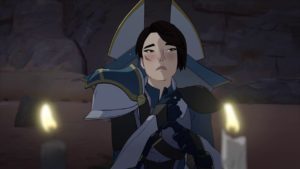 Imagine that you are a huge fantasy or science-fiction fan. You’ve watched every Game of Thrones episode. You own all of the merchandise. You’ve seen the “Lord of the Rings” and “Star Wars” trilogies so often your friends never need to ask what gifts you want for the holidays. Even your cat is named ‘Aragorn’.
Imagine that you are a huge fantasy or science-fiction fan. You’ve watched every Game of Thrones episode. You own all of the merchandise. You’ve seen the “Lord of the Rings” and “Star Wars” trilogies so often your friends never need to ask what gifts you want for the holidays. Even your cat is named ‘Aragorn’.
Now picture the next big movie you’re excited about is announced. You watch all the actor interviews, cling to every spoiler and hint dropped by the studios, and the week before the premier you have your head shaved to carve your favorite clan symbol into your left temple.
Except when the movie comes out, you can’t watch it. It’s in a foreign language and the only way for you to enjoy it is with a small glass device attached to your chair that keeps slipping. You can watch the words or the action, but not both. At the end of the film all of your friends are going on and on about the wonderful fight scene with the main heroes but all you saw was your subtitles dropping away when someone bumped your chair going to the bathroom and you scrambled to put it back.
Oh sure, you could wait for it to come out dubbed in English, but you’ll have to wait for an entire week. A week of all of your friends ruining the best scenes because they’ve seen it already. Or avoiding all social media and TV because you don’t want to stumble on any spoilers. And when it does come out, you’ve scene all the best scenes already because it’s all people put on your fan sites since opening night.
Now imagine you’re Deaf.
There are two kinds of deafness in the United States: ‘small-d’ deafness and ‘large-D’. ‘Small-d’ deafness is the result of hearing loss. Advancing age, congenital hearing loss, or just too many rock concerts can all cause hearing loss.
Big-Deafness is a culture and history within the United States that communicates with American Sign Language, cherishes Deaf History, and fights for equal access to things like captioning for new movies. Deaf, Hard-of-Hearing, and Children of Deaf Adults can all identify with the Deaf Community, and several more like this author work or live with them as friends or colleagues.
With advances in technology, cellphones and texting have vastly improved the access Deaf people have to everyday conveniences like calling the cable installer or booking a restaurant. FaceTime and video relay enable them to call anywhere and anytime for taxicabs or doctors’ appointments. There is so much access in fact, that places where they cannot have access have become the glaring exception.
Like captioning.
Deaf people buy manga and watch drone races. They buy Millennium Falcon replicas and write Elvish. They roll dice, draw orcs, dream about dragons and buy fantasy novels just the same as every other fan of the genre. The only thing they can’t do is hear.
In cultures defined by their ability to supersede reality, shouldn’t all Fantasy and Science-Fiction be accessible? Shouldn’t conventions be close-captioned and panelists interpreted? Can’t more movies or television series use American Sign Language for their characters like The Dragon Prince show does with their Deaf General Amaya on Netflix? Productions that include Deaf and Hard-of-Hearing actors, even as extras, are still woefully small. Do you really need to hear to dress like a zombie and eat people? Or add shadows to an alien monster’s CGI graphics?
A person’s gender, sexual orientation, ethnicity or social class are not the only obstacles preventing brilliant and invested fans from reaching their ideal careers or childhood heroes. Let all people be Writers. Let them be Artists.
Let them be Dreamers.
 Biography: TJ Kahn is an American Sign Language interpreter and retired hospital chaplain living in the San Francisco East Bay. A sci-fi/fantasy enthusiast and a devoted dog parent, he stays active supporting Podcasts and various artists, hoping to become a professional game designer himself someday.
Biography: TJ Kahn is an American Sign Language interpreter and retired hospital chaplain living in the San Francisco East Bay. A sci-fi/fantasy enthusiast and a devoted dog parent, he stays active supporting Podcasts and various artists, hoping to become a professional game designer himself someday.
Follow him on Twitter as Theopedes.
June 4, 2019
So Long, and Thanks for All the Fish
 The Nebulas this year were an amazing, dazzling, staggering blur, and an overall splendid time. (I got a selfie with William Gibson plus shared french fries with an astronaut!). But there was one sad thing for me, which was that in all the shuffle and mistimings, I didn’t get a chance to deliver the speech I’d prepared.
The Nebulas this year were an amazing, dazzling, staggering blur, and an overall splendid time. (I got a selfie with William Gibson plus shared french fries with an astronaut!). But there was one sad thing for me, which was that in all the shuffle and mistimings, I didn’t get a chance to deliver the speech I’d prepared.
I’ve been spending some time post-Nebulas thinking and reflecting on everything I’ve learned from the SFWA Presidency, and all the valuable things I’ve discovered and learned as a result of my time in office. Over the next few weeks, I’ll publish the blog posts I have been putting together, one dedicated to each year, and then a final recap. It seemed a logical thing to kick that series off by sharing that speech, which contains a number of things I wanted to say to the SFWA family at large. I hope this serves.
Six Nebulas ago, Steven Gould approached me. He needed someone who’d be willing to run for Vice President the following year, picking up a one year term as SFWA made the transition to staggering the terms of the Vice President and President. He promised me it would be only a one year obligation. Insert hollow laugh here.
July 1st will mark a big transition in my life: after five years on the SFWA board, spending one year as Vice President under Steven Gould, and then two terms as President. I have spent more time on the SFWA board than most people do getting their college degree, and that is an odd thought. General wisdom is that the SFWA Presidency eats a book a year; I have definitely found that true, and I suspect a large number of stories got consumed as well. I am looking forward to becoming actually productive again.
But there have been a multitude of compensations. A wealth of friendships. An abundance of moments that delighted my heart or that felt like tremendous victories. There is a tendency to label SFWA governance toxic, to imply that it destroys the soul and hollows one out. I am pleased to report that this is not actually the case, that I have found it, on the whole, a community that is welcoming and well-intentioned, though not always graceful in expressing it. I step down feeling the better for the five years in which I have learned and grown.
I have presided over both the first and the second all-female President/Vice President teams in SFWA history, the first time M.C.A. Hogarth and myself, the second time Erin Hartshorn and myself. I had thought that perhaps now handing the Presidency over to Mary Robinette Kowal represented another historic first, only to find this was not so. The first female to female SFWA Presidency exchange actually took place in 2003, when Sharon Lee handed the reins over to Catherine Asaro. I’m taking part in a panel tomorrow called “We Have Always Been Here,” about women in science fiction and this underscored that truth. We have indeed always been here, doing much of the work that drives this community.
Three women have been working with me side by side every moment of this remarkable journey, and all three remain with SFWA, for which you are all very lucky. I ask them to stand as I mention them, and for a round of applause at the end, because without them I could not have stayed the course.
The first is Sarah Pinsker, who agreed to come onto the board at the same time I did and who has remained a Director at Large whose thoughtful, considered presence has contributed enormously to discussions, as well as seeing through multiple projects, including but not limited to the Baltimore Book Festival and the Mentoring Program, and being a consistent voice for marginalized writers.
The second is Oz Drummond, who has been part of the financial team first under the inestimable Bud Sparhawk, and then under the equally awesome Nathan Lowell, and who has worked to learn more about how a nonprofit 501C3 works than anyone else I know. I have seen much of Oz’s surroundings during our weekly SFWA video calls, as well as her cats, the wild turkeys, and various backyard deer. I will greatly miss those conversations.
The third is Kate Baker, our Executive Director, with whom I have fought shoulder to shoulder against the forces of chaos, miscommunication, and random bad luck. I cannot say enough about Kate, or we would be here forever, but suffice it to say, any team she is on is lucky to have her. Not just love, but mad props to you, Kate, for the amazing job you’ve done during my five years on the board.
And finally, thank you to you all, not just the people in this room, but the SFWA members watching or reading from afar. Thank you for your trust, your advice, your support, and your friendship. Thank you for the many times you reached out to tell me I was doing a good job. And thank you to the ones who weren’t afraid to call me on it when you thought I wasn’t. I have tried to validate your trust and, like you, to be welcoming and well-intentioned, though not always graceful in expressing it. I hope these inadequate words meet with your approval. And congratulations to Mary Robinette again, with many thanks for being willing to run for the office.
End speech and then we would all go drink and listen to the Alternate Universe acceptance speeches, which is perhaps where this speech should have been delivered. 
June 1, 2019
Where I’ll Be: Cascade Writers Workshop
If you’re coming to the Cascade Writers Workshop, this is where you’ll find me.
Friday:
9:30-10 AM: Registration and meet & greet with tea & coffee! Conference Room
10 AM-11:50 AM: Critique group meeting 1:
Curtis Chen & Cat Rambo: Breakfast Area
3 PM-4:50 PM: Critique group meeting 2
Curtis Chen & Cat Rambo: Breakfast Area
8 PM- 8:50 PM: Getting To The Finish Line, Cat Rambo, Conference Room
Do you have trouble saying goodbye–or getting through the middle? Cat Rambo will show you strategies to get from a kernel of an idea, a stalled beginning, a soggy middle, or a dead-at-three-quarters to the end.
Saturday:
9 AM-10 AM: Meet & greet with tea & coffee! – Oak room
10 AM-11:50 AM: Critique group meeting 3:
Curtis Chen & Cat Rambo: Breakfast Area
3 PM-3:50 PM: Respect The Hustle, Spencer Ellsworth, Cat Rambo & Jaym Gates, Conference Room
Selling a short story, a book or an article will net you a paycheck–but how do you turn that into income? How do you take freelancing seriously, and combine fiction writing with other ventures to make your writing and editing skills bankable? In other words, how do you get the hustle, keep that hustle, and respect that hustle?
7:30 PM-11 PM: PUB NIGHT! Lovecraft Brewing, 275 5th St, Ste 101, Bremerton, WA 98337
Come across the street to Lovecraft Brewing to drink, eat, buy books from the Liberty Bay Books table, and hear our panelists read from their work!
Sunday:
9 AM-10 AM: Meet & greet with tea & coffee! – Conference room
10 AM-10:50 AM: Critique group one-on-one meetings:
Curtis Chen & Cat Rambo: Breakfast Area
2 PM-2:50 PM: Workshop wrap-up, board meeting & feedback! – Conference room
May 30, 2019
Guest Post: Walnut & Pumpkin Risotto by Ben Isham-Smith
 Raised by an Italian mother (don’t let my embarrassingly anglicized name fool you), the kitchen formed the hub of all activity in our home growing up. Not just for cooking meals, but also entertaining, welcoming guests, and even eating.
Raised by an Italian mother (don’t let my embarrassingly anglicized name fool you), the kitchen formed the hub of all activity in our home growing up. Not just for cooking meals, but also entertaining, welcoming guests, and even eating.
If anything happened in our home, it happened in the kitchen.
Few recipes stir up the memories and emotions I associate with then as risotto does. My mother had her own go-to risotto recipe that had evolved over the years she had learned it from her own mother, and it became a monthly tradition for her to cook up a batch of risotto rice, leek and chicken, which would keep us going for days.
I’m a big fan of meals that can be cooked in a pot. Not just because they can often be a bit more ‘hands off’ than other types of recipe (I’m infuriatingly lazy), but also because I find there’s more room to improvise and tweak it in line with your own personal preferences.
This risotto recipe is a bit braver than more traditional takes on the Northern Italian dish. It matches traditional risotto elements, like white wine, onion and garlic, with a much more outlandish pumpkin and walnuts. If I’m honest, I don’t think my Italian grandparents would approve (in fact, I know they wouldn’t – they never forgave me for my lazy tiramisu recipe) but if I didn’t deliberately undermine them at every given opportunity, then what kind of grandson would I be?
The truth is though, despite my tweaking on it, the recipe does still remind me of learning to cook in our home kitchen in the middle of the Berkshire countryside. And if a recipe can stir up intense memories like that, then it’s served its purpose.
One of the greatest cooking fallacies is that making a good risotto takes a lot of time and skill. Well, you’ll be glad to hear it only requires a good amount of time, and simply no skill. Fortunately this means that even someone as clueless as me can make it.
All this recipe needs is a lot of patience, and definitely a lot of stirring. Your arm might take a little while to forgive you, but the dish you get at the end more than makes up for it
If you’re making this in autumn or fall then you might already be drowning in pumpkin-inspired dishes (pumpkin lattes, pumpkin cookies, even pumpkin peanut butter), but this is too good not to try. Furthermore, it’s a great dish to break out for Thanksgiving as a vegetarian alternative to the more traditional meat-heavy meals on offer.
That said, I still love to break it out year-round, and enjoy it just as much in the summer.
Pumpkin & Walnut Risotto
Prep Time
10 mins
Cook Time
45 mins
Total Time
55 mins
Servings: 2 people
Ingredients
1 cube Vegetable Stock
500 ml Water boiled
50 g Butter
1 White Onion. Finely Diced
1 Stick of Celery. Finely Diced
1 Garlic Clove. Finely Diced
150 g Arborio Risotto Rice
125 ml White Wine
150 g Pumpkin Puree
25 g Butter
50 g Roquefort Cheese crumbled
50 g Walnuts chopped
Salt and pepper to taste
Instructions
Add the vegetable stock cube to the boiling water and stir in thoroughly.
Heat up a large frying pan over a medium heat, add 25g of the butter.
Once the butter has melted, add the onion and celery. Cook for 10 minutes until softened.
Stir in the rice, until the grains start to turn translucent at the edges.
Turn up the heat a notch to medium-high, adding in the white wine. Stir until all the wine has disappeared. Add the dried sage.
Slowly stir in the vegetable stock by adding in one full ladle at a time, stirring continuously until fully incorporated and the rice is cooked. Do this over the course of about half an hour.
Stir in the pumpkin puree and take off the heat. Place a lid on top and leave to rest for 5 minutes.

As the risotto rests, melt the other 25g of butter in a separate frying pan add the walnuts to toast.
Serve the risotto. Top with the crumbled roquefort cheese and buttered toasted walnuts.
About the author:
Ben is a former semi-pro cyclist and big eater. Now he is just a big eater. He writes about food and drink for lazy cooks at The Eat Down.
May 28, 2019
Where I’ll Be: Origins 2019 Author’s Library Panel Schedule
Thursday, June 13:
10am-11am: Short Stories: How do you plot something that’s only 5k? How do you know it’s going to come out that long? Tips and tricks to crafting a good short story. Lucy Snyder (M), Carlos Hernandez, Cat Rambo
3pm-4pm: Reading for Writers: How important is it for a writer to be well-read? Are there books every writer should know? Come for a lively debate on something every writer knows something about: reading. Mercedes Lackey, Cat Rambo, Tracy Chowdhury, Addie J. King, Gregory A. Wilson (M)
Friday, June 14:
10am-11am: Effective Illusions: How do you make a reader feel as though they’re actually there in the world you’ve created? Join our panelists for tips and tricks on building worlds that are evocative, enchanting, and above all, so immersive you can lose yourself in it and forget you’re reading. Carlos Hernandez, Cat Rambo (M), Doc Myers
Saturday, June 15:
10am-11am: Professional Writing Organizations: What is SFWA and what does it offer? What about HWA? IAMTW? Which ones should you join—if any? Cat Rambo, Jennifer Brozek, Aaron Rosenberg (M)
3pm-4pm: Branding & Marketing Yourself and Your Content: Running a podcast, releasing short fiction for free, blogging, Tweeting, etc. All the different ways to identify and bring more attention to your writing and your brand. Larry Dixon, Michael R. Underwood, Robyn King, Cat Rambo, Gregory A. Wilson (M)
May 9, 2019
Where I’ll Be: Gen Con Writer’s Symposium 2019
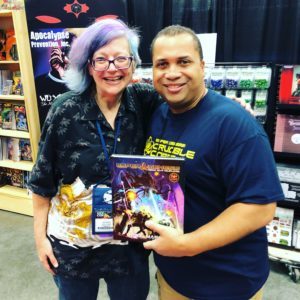
A favorite moment with Christopher Negelein from last year’s Gen Con!
I’m looking forward to another chance to participate in the Writers Symposium at Gen Con this summer! Indiana is the state I was raised in, and there’s lots of chances to see old friends as well as my brother Lowell. I also did well in this year’s hotel lottery, so socializing will be easier.
The first Gen Con I ever went to was back when I was a teenager and first playing D&D. It’s always amazing to see how far the game has come as well as how much more mainstream it’s become, as well as how much more diverse. The Writers Symposium is always well-organized and a great chance to hang with fellow writers who also happen to be gamers.
I’ll be participating in the Worldbuilders fundraising event once again as well, come play Settlers of Catan with me.
THURSDAY
12 PM Ballroom 2
What Can SFWA Do For You
Cat Rambo (M)
1 PM Signing Table
Signing
Cat Rambo, Patrick Tomlinson
2 PM Austin/Boston
Writing Steampunk and Weird Western
Cherie Priest, Cat Rambo (M)
5 PM Ballroom 1
Podcasting
Tee Morris, Anton Strout, Cat Rambo, Steve Drew (M)
FRIDAY
10 AM Austin/Boston
Science Fiction: What’s Next?
Cat Rambo, Patrick Tomlinson, Toiya Finley, Corry Lee, Kirk Dougal (M)
4 PM Atlanta
The Ins and Outs of BookBub
Christopher Morgan, Elizabeth Vaughan, Cat Rambo, Corry Lee (M)
5 PM Atlanta
MESSAGE! Writing Books with Timely Themes
Carol Berg, Karen Bovenmyer, Melissa F. Olson, Cat Rambo (M)
SATURDAY
1 PM Ballroom 2
Witty or Sh*tty?: How To Be Funny, and When Not To Be
Patrick Tomlinson, Bryan Young, Scott Lynch, Cat Rambo (M)
4 PM Ballroom 3
When the Mob Rules on Social Media
Patrick Tomlinson, Cat Rambo, Keith Law (M)
May 8, 2019
Guest Post: M. H. Thaung Discusses How and Why Do People Make Bad Decisions?
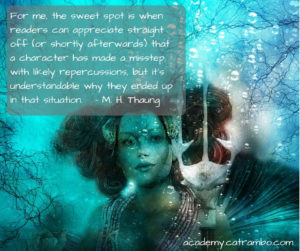 When I read or write fiction, I like seeing characters make bad decisions and then deal with the consequences. However, if they make those decisions for implausible reasons, they can appear silly or inconsistent rather than attracting sympathy. If they’re forced into decisions because of overwhelming external factors, they may come across as lacking agency. In both cases, the decision seems made purely to further the plot rather than arising naturally. For me, the sweet spot is when readers can appreciate straight off (or shortly afterwards) that a character has made a misstep with likely repercussions, but it’s understandable why they ended up in that situation.
When I read or write fiction, I like seeing characters make bad decisions and then deal with the consequences. However, if they make those decisions for implausible reasons, they can appear silly or inconsistent rather than attracting sympathy. If they’re forced into decisions because of overwhelming external factors, they may come across as lacking agency. In both cases, the decision seems made purely to further the plot rather than arising naturally. For me, the sweet spot is when readers can appreciate straight off (or shortly afterwards) that a character has made a misstep with likely repercussions, but it’s understandable why they ended up in that situation.
In my day job in a pathology lab, mistakes can have serious, even fatal, consequences. We try our hardest to minimise them as well as spotting and correcting them as early as possible. When (not if—we’re human, after all) a mistake happens, we investigate the reasons and see what we can do to prevent a repeat. Additionally, at corporate level, we are expected to attend courses on how to make systems safer. Such training can be a chore, but for me it has one significant plus: it’s fertile ground for ideas about where characters may go wrong.
I’d like to share here how I set up my characters’ unforced errors, allowing them to make plot-influencing mistakes in a realistic manner. The concepts aren’t new, but using risk management ideas helps me to flesh out details. This isn’t an academic treatise, so I have cherry-picked knowledge from workshops on error, mandatory training and general wider reading. Also, the definition of “wrong” in this context might be fluid, but I’d view it as something suboptimal for the character’s intentions (and interesting for the reader).
First, I think about the character’s environment and what real-life factors might lead the character in the wrong direction. What kinds of flawed reasoning might the character(s) use, and why? And what organisational/social factors might create an environment where it’s easy to make mistakes?
Human errors
The Health and Safety Executive (http://www.hse.gov.uk) categorises human failures as errors (unintended actions or decisions) or violations (intentional deviation from a rule or procedure). The latter is a common trope in stories, with the protagonist deliberately acting against authority in order to achieve a greater good, often with an awareness that such behaviour will incur a cost. I’ll concentrate on the former.
One type of error is the slip or lapse, where a habitual or familiar task is for some reason not completed as planned. Such tasks need little concentration to perform correctly: for example, driving home, cooking dinner, tying up the fiftieth captive in a row. It’s difficult to predict when a slip or lapse might occur. Factors such as time pressure or distractions increase the risk. In fiction writing, we could imagine a situation where a character’s routine is derailed slightly by a distraction or being in a hurry. Such a lapse (e.g. leaving keys on the table by the cell) could have knock-on consequences.
The other type of error is the mistake. This involves a wrong judgement or decision made with conscious thought (in the “attentional control mode”), and it leads to a wrong action. Such errors often occur in situations that are unfamiliar. Whether or not we appreciate the newness of the situation, we might try to apply known rules. For example, a character might eat (or feed another character) a poisonous herb because it looks like a beneficial one.
Added to the above, our decision-making is often influenced by different types of bias (i.e. a subjective preference for or against something without firm evidence).
Flavours of bias include:
Anchoring bias. When there are several options available, anchoring bias is the tendency to lock on to a specific option, and to fail to reconsider when subsequently given evidence against it. Often the favoured option is first (or early) in the list, and items in the middle of the list receive less attention. Thus, the order in which options are presented may influence the decision. An example of this in fiction might be a murder mystery when the detective identifies a likely suspect early on. Further clues point more strongly towards other people, but the detective brushes those aside until faced with an unpleasant shock (such as a second murder when the favoured suspect is in custody).
Cognitive overload bias. If someone is presented with more information than they can reasonably process, they are forced to ignore some of it. This means that they may make a decision without considering all the relevant information (because they were focussed on other factors).
Of course, decision-making doesn’t occur in isolation. In fiction (as in real life), individuals will have multiple concerns, personal agendas, interpersonal conflicts and other problems that can add deliciously to their challenges.
Organisational factors
People don’t function or make decisions in isolation. There are aspects of their environment that may hamper them—or, alternatively, that they could manipulate in order to get their way.
One point to stress about the organisation (tribe, crew, social system etc) that a character functions in is that the organisation’s prime purpose is generally not to make the character’s life difficult. That said, there are real-life organisations where the environment doesn’t facilitate good decision-making: not because of maliciousness, but because the setup is poor. Several examples are discussed in The Blunders of Our Governments by King and Crewe. I’ve picked a few concepts from the book which can complicate life for fictional characters.
Group-think. In a group of people tasked with an objective, maintaining the group’s cohesion by avoiding disagreement may become more important than raising concerns. Nobody wants to be “that person”, and so everyone remains silent about an obvious problem that could be easily anticipated. Our hapless character may be on the receiving end of a bad decision by such a group. Alternatively, he or she might have been part of such a group, witness the fallout of the bad decision and feel obliged to deal with the consequences. As an example, in my first book A Quiet Rebellion: Guilt, my main character (Jonathan) tentatively suggests to the Chief Scientist that some of her reasoning has been wrong. She’s built her career on her research, and she’s not going to hear him out—and her colleagues don’t seem inclined to contradict her.
[Chief Scientist Lady Nelson says] “… She must have ventured outside the city walls on some escapade. Don’t you agree?”
“Ah, I don’t think so, ma’am.” Jonathan squared his shoulders. She wasn’t going to like this. “I believe there are historical accounts—”
“Pah, historians!” Lady Nelson scowled and shook her head. “All they do is dig through old stories without paying any attention to real world data. History is all very well for looking at how society developed, but not for finding out how the world really works. We do not deal in fairytales, Captain Shelley.”
Cultural disconnect. “Everyone projects on to others his or her lifestyles, preferences and attitudes.” (From King and Crewe). Cultural disconnect arises when a group (usually in power) assumes that others can and will think and react similarly to them, including holding the same values. It’s easy to imagine a fictional character being the one imposed upon, or trying to find some way to translate superiors’ orders into a language that’s meaningful on the shop floor. Sticking with Jonathan, he’s now reporting back to the Council in the capital about how his tour of the rural settlements went. Chief Councillor Hastings asks how the new regulations were received. Jonathan has an internal grumble that the documents are written in bureaucratese, but replies:
“The settlements remain vigilant and are familiar with current official advice.”
[Hastings nods] “Good. Nice to know they pay attention to those notices we send out.”
Hastings isn’t trying to make things difficult, but his casual comment (compounded by Jonathan’s unwillingness to complain) suggests he doesn’t expect there to be a problem. His concern is that the rurals remain willing to cooperate, not whether they can understand him.
Operational disconnect. This is a gap between those who devise plans or policies, and those whose job it is to implement them. In fiction, this might risk becoming a simplistic plot device where those in charge make unreasonable demands of a character, purely to force a plot-convenient challenge and conflict. However, if there is clarity over why the plans were thought to be reasonable (not necessarily fully played out on page), the challenge feels less artificial. In the Council meeting above, Jonathan reports how a rural mayor made a mistake (based on wrong implementation of one of the regulations), but he glosses over things in the telling. After all, he already yelled at the mayor at the time, and there’s no point in escalating things. Unfortunately, Jonathan’s reprimand leads the mayor to overcompensate in the other direction. When news of the second incident reaches Jonathan, he partly blames himself, but he was caught between the instructions of the Council and the practicalities of the settlements.
Round up
I believe that that characters’ poor decisions feel more compelling if there are on-page or behind-the-scenes reasons leaving them vulnerable to making mistakes. The concepts discussed above aren’t new, and writers are no doubt using them already. I offer them here as an additional set of tools. I use them to brainstorm how to bridge the gap between what a character would rationally do and what I (as the character’s creator) need to happen.
Author bio for M. H. Thaung
 M.H. Thaung was born in Scotland and has moved progressively southwards throughout her career in pathology, ending up in a biomedical research institute in London, England. (As a staff member, not a specimen!) She loves her job and academic writing, with dozens of scientific publications over the last couple of decades. More recently, she has ventured into speculative fiction to discover what might happen if the world worked a little differently.
M.H. Thaung was born in Scotland and has moved progressively southwards throughout her career in pathology, ending up in a biomedical research institute in London, England. (As a staff member, not a specimen!) She loves her job and academic writing, with dozens of scientific publications over the last couple of decades. More recently, she has ventured into speculative fiction to discover what might happen if the world worked a little differently.
She’s currently working on A Quiet Rebellion: Posterity, the final novel in her Numoeath mannerpunk trilogy. A Quiet Rebellion: Guilt and A Quiet Rebellion: Restitution were released last year.
Website: https://mhthaung.com/
Twitter: https://twitter.com/mhthaung
Enjoy this writing advice and want more content like it? Check out the classes Cat gives via the Rambo Academy for Wayward Writers, which offers both on-demand and live online writing classes for fantasy and science fiction writers from Cat and other authors, including Ann Leckie, Seanan McGuire, Fran Wilde and other talents! All classes include three free slots.
If you’re an author or other fantasy and science fiction creative, and want to do a guest blog post, please check out the guest blog post guidelines
May 7, 2019
Notes from the Internet Presence for Writers Panel
 This is from the panel on Internet Presence for Writers from Norwescon a few weeks ago. Participants were K.G Anderson, K. Tempest Bradford (moderator), Chimedum Ohaegbu, and myself.
This is from the panel on Internet Presence for Writers from Norwescon a few weeks ago. Participants were K.G Anderson, K. Tempest Bradford (moderator), Chimedum Ohaegbu, and myself.
Panel description: We’ve all heard the warnings, “Be careful what you put online; it’s forever!” Is this really a concern? We’re encouraged to have a heavy online presence, but sometimes it can feel like walking on eggshells. Hear pros share how they balance their fanbase and personal sharing, where it’s gone right and gone wrong.
One of the keys is to be findable on the Internet. You should have a website, and that website should have a means of contacting you. You would be surprised how many writer websites do not have the writer’s name on the front page.
Along the same lines, that website should look professional rather than amateurish. If you must have squid, Karen observed, make them professional looking squid.
Curate your presence and don’t be random about it. You want to think about your online presence. Look at your social media and the last 20-25 things you’ve posted. How many are positive? How many are negative? How many are informative? That’s the presence you’re projecting online. People are drawn to people who care about people.
Have a newsletter. Raven Oak’s was held up as an example.
Facebook groups are more useful than Facebook pages. (note from Cat: I’m been hearing this for a while and it did lead me to start up a group, which so far has been livelier and more active than anywhere else for me on Facebook.)
Post proportionately and consistently.
Don’t let social media overwhelm your energy. You must have something to promote or all of this is pointless.
Use Twitter tools like Buffer or Hootsuite to keep things manageable by scheduling posts. Twitter lists are also useful. Cat keeps a private list marked “interactives,” which is people who frequently interact or repost her stuff, which is the first place she pulls from when scheduling posts. Another is a public list, Women in Fantasy and Science Fiction. To see what lists you are on, go to your Lists page and click on “Member of”.
Explore Twitter hashtags like #writingcommunity, #writerwednesday, #followfriday. On Instagram, look for #bookstagram and other book-related hashtags.
Blogging is coming back, but you need to have content that people want. Mary Robinette Kowal has a series called Debut Author Tips, for instance.
May 6, 2019
Guest Post: Thoughts on How and Why to Write Non-Human Protagonists by S. R. Algernon
As a writer, sometimes I find myself inspired to write by seeing other writers use a particular device and wondering what I can do with it. Having grown up with Star Trek and the Twilight Zone, and having encountered Babylon 5 in my teenage years, I felt confined by the typically anthropomorphic aliens, particularly the ones that were obvious stand-ins for Russians or Romans or other human cultures. The aliens were usually in supporting roles, and their biology, worldview and motivations were usually within human norms, not counting special abilities. I appreciated these characters and their stories, but I wondered how far writers could push the envelope in adopting an alien perspective. The Star Trek episode “Devil in the Dark” gave agency and purpose to a non-humanoid life form, and works like Lem’s Solaris, showed aliens that can be beyond alien understanding, but I wondered what stories could be told from non-human perspectives and how they could contribute to the genre.
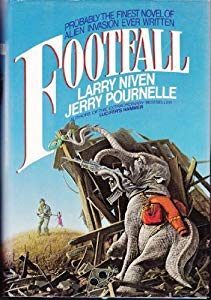 Footfall by Larry Niven and Jerry Pournelle gave me a more expansive sense of what could be accomplished by setting a story within a non-human perspective. The Left Hand of Darkness by Ursula K. LeGuin and “Story of Your Life” by Ted Chiang inspired me to consider reproduction and language that departed from the human norm. They drew me to non-human stories and came to enjoy stories that normalize aliens and de-normalize human experience,
Footfall by Larry Niven and Jerry Pournelle gave me a more expansive sense of what could be accomplished by setting a story within a non-human perspective. The Left Hand of Darkness by Ursula K. LeGuin and “Story of Your Life” by Ted Chiang inspired me to consider reproduction and language that departed from the human norm. They drew me to non-human stories and came to enjoy stories that normalize aliens and de-normalize human experience,
It is important to distinguish between stories that aim primarily to tell an alien story and those that use the alien as a prop in an allegory about human society. While the latter trope is common (“Eye of the Beholder” in Twilight Zone, “Let This Be Your Last Battlefield” in Star Trek, etc.), they can be too neatly prepackaged, so that the audience merely interprets the message, as explained by the human characters, rather than engaging in an alien experience.
Humans, at heart, are pattern detectors; the patterns of our daily lives inevitably become biases and prejudices. We can sometimes erode those prejudices by stepping outside of our usual experience and our usual metaphors for understanding the world (even the phrase “stepping outside” is grounded in human biology). Naturally, an alien world created by a human author will draw from human experience, but the characters’ thoughts and actions should be tangibly grounded in their own environment.
Like Plato leading prisoners out of his eponymous cave, a truly alien story, told within its own worldview, for its own sake, can expand the reader’s experience without framing or explaining the story in terms of a human cultural narrative.
I find that immersing myself in an alien culture without an easy allegory or a human narrative to explain the story can push me as a reader to be cognitively flexible and to understand others without necessarily expecting the experience to translate readily into their own.
So, what would I like to see more of from non-human characters in science fiction, and why? Here are a few ideas (for me, and for any other writers out there looking for a challenge). To show that I’m trying to practice what I preach, I’ll raise a few examples from my recently-completed #NaNoWriMo novel, Elevation, which is told in part from the perspective of an insectoid race.
Sensory systems: Non-humans in sci-fi almost invariably have the same senses as humans. If there is a sensory difference, it usually comes across as a one-off special ability. Other animals on Earth have sensory systems that differ multidimensionally across the senses. There are different color palettes, different ways of perceiving sound, and so on. Once an animal perceives something, it is classified and responded to in the context of its evolutionary history. One needs only consider the diversity of ways in which insects and birds, for instance, use sound and color, to appreciate what we will face when encountering extraterrestrial life. Even trained scientists can fail to appreciate ultraviolet light, infrared radiation, ultrasound, magnetic fields and other sensory cues. It also bears noting that different animals (and different humans) can perceive the same sensory information in different ways.
In my most recent novel project, Elevation, my characters communicate mainly through sound and smell. The use of smell means that – particularly in the cities – their social world is literally part of the atmosphere, shaping individual character interactions and cultural landscapes.
Communication: How many times do first contacts start with a simple message delivered through a straightforward audio message (such as “Take me to your leader”) without much thought into how the aliens perceive and use human language and how those words relate to their own concepts of the world. A Far Side comic strip parodies this by showing aliens with hand-shaped heads who – as it turns out – do not take kindly to a human attempt at a handshake. “Story of Your Life” explored non-linear communication (expressed well visually) in the movie Arrival), and it raises the question of how else alien communication could differ from our assumptions. How would an intelligent species use smell or touch to communicate?
In Elevation, the characters use their sense of smell to identify individuals socially. As a result, they do not, strictly speaking, have auditory or visual “names’ for each other, which poses a problem for humans trying to keep them straight. This has been a challenge for me when writing dialog and narration, but it compels me to think about the characters’ identities in new ways.
Agency and autonomy: It is important to me that the non-humans are more than talking points for the human characters’ debates. The characters should act in accordance with their own drives, in the contexts of their own worldview. This can be challenging as a writer because human readers will have moral expectations even of non-human characters. However, it is unreasonable to think that characters will act the way humans expect them to or strive toward human morality (which is hardly a monolithic construct anyway) unless led to do so by interaction with humans.
For example, the protagonist in Elevation has had children in the past, but – like some Earth insects – left the eggs behind after laying them and expresses no parental feeling toward them. Tending to young is driven by pheromones and is seen as a civic duty to the colony rather than a social bond. This is not framed as a statement on human parenting, but as an expression of the character’s drives in cultural context.
Reproduction: One of the primary drives (or the primary drive, depending on who you talk to) is reproduction. Whether or not we as individuals reproduce, our drives and our behavior are a product of the behaviors that led our ancestors to successfully reproduce (or else we would not be here). These behaviors, as they often are in humans, could be shrouded in social norms and mechanisms of social control, but these would be different from human norms.
For instance, in Elevation, the non-human characters reproduce parthenogenetically (through virgin birth) unless the eggs are fertilized by the King, the city’s sole male. Care for the fertilized eggs is done at hatcheries and nurseries near the Royal Palace, so care of larvae by individuals outside the city is seen either as putting on airs or as a desire to create a rival colony with a new king. These forces create social injustice and conflict, but in a way that differs from human conflicts.
In short, I like to explore non-human societies not to understand the human condition better, per se, but as a way of exploring the wider, underlying conditions that are a foundation not only for humanity but for intelligent life in a more general sense. It could be argued that science fiction and fantasy are meant for humans and, as such, that even the non-human characters will be seen through a human lens. I think there is truth to that, but I believe that the more clearly that an author can establish the worldview of all characters, the less vulnerable we are to literary solipsism, where are characters are simply preaching our own worldview back to us.
As we get into the habit – as readers and writers – of fleshing out alien characters in their own terms, perhaps we will be more vigilant in expecting the same from our human characters. Our concepts of normality, having been stretched by science fiction, might find themselves more capable of accepting the ways that we humans are alien to one another. It will encourage us, particularly in these tumultuous times, to move beyond simple allegories to examine the deeper underpinnings of our differences. I can’t say myself whether my work rises to that lofty ambition, but it is a goal well worth aiming for.
Works Cited
Chiang, T. (1998). “Story of your life.” Stories of your life and others,
117-78.
Larson, G. (2003).The Complete Far Side: 1980-1994. Andrews McMeel Pub.
Le Guin, U. K. (2012).The Left Hand of Darkness. Hachette UK.
Lem, S. (1970) Solaris. Walker & Co (US).
Niven, L., & Pournelle, J. (1985).Footfall. Del Rey.
Roddenberry, G. (1966). Star Trek. Desilu/Paramount
“Devil in the Dark” (1967) by Gene Coon and Gene Roddenberry.
“Let This Be Your Last Battlefield” (1969) by Oliver Crawford and Gene
Roddenberry.
Serling, S. Twilight Zone. (1956) CBS Productions.
“Eye of the Beholder” (1960) by Rod Serling.
Straczynski (1994). Babylon 5. Warner Brothers.
 Author Bio: S. R. Algernon studied creative writing at the University of North Carolina at Chapel Hill. He has been published in Nature and Daily Science Fiction, and is the author of two short story anthologies, Walls and Wonders and Souls and Hallows. Both can be found at: https://sralgernon.wordpress.com/anthologies/. He currently resides in Michigan.
Author Bio: S. R. Algernon studied creative writing at the University of North Carolina at Chapel Hill. He has been published in Nature and Daily Science Fiction, and is the author of two short story anthologies, Walls and Wonders and Souls and Hallows. Both can be found at: https://sralgernon.wordpress.com/anthologies/. He currently resides in Michigan.
April 23, 2019
Guest Post: Andrew Hiller Finds ‘S Wonderful at the Baltimore Faerie Faire
 What fun! I really didn’t know what to expect when I accepted the Author of the Year recognition from the Baltimore Faerie Faire, but there was belly dancing, big bands, folk music, a hoard of really cool/fun people…
What fun! I really didn’t know what to expect when I accepted the Author of the Year recognition from the Baltimore Faerie Faire, but there was belly dancing, big bands, folk music, a hoard of really cool/fun people…
AND I was given a key to the Faerie Kingdom!
It all started when I received a random Facebook friendship invite. I checked out their stream before accepting (My sister taught me to do this.) Happily, the person passed the spam test so I clicked “approve.” Almost immediately I received an IM.
My newest friend started off by thanking me, and launched into how much she loved A Halo of Mushrooms. She’d picked up a copy at Mars Con in January, devoured it, read passages to her husband, and brought it to the attention of her reading group. I felt flattered and thanked her. Then, she added that she was one of the organizers of the Baltimore Faerie Faire and not only wanted me to come, but to be their author of the year.
Swim, small fish, swim!
I got the details, checked out the website, and said, “Yes.”
It turns out the Baltimore Faerie Faire is not only a warm community, but enough of a big deal to be included in the official state of Maryland’s tourism website. It took place over two days. On April 13th, they held the Masquerade Ball and on 14th was the Faire itself. My major duty was to step before the faerie court to ease the transition between the seasons and aid in the passing of the baton from the Winter Queen to the Spring. I also had a table for signings and some other authorly roles. Both Seelie and Unseelie.
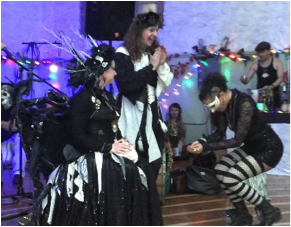 The Ball was great. Spritely music played as professional burlesque dancers, belly dancers, and folk dancers twirled on the floor. In between, the attendees boogied… or is that bogied.
The Ball was great. Spritely music played as professional burlesque dancers, belly dancers, and folk dancers twirled on the floor. In between, the attendees boogied… or is that bogied.
When I was introduced during the Ball as the man of the hills and 2019 Author of the Year, they gave me a key to the Faerie City! Everything went as smooth as faerie dust. On the second day… well, you know that something always happens during live performance!
The second court began with the faerie queen of winter, the magpie, resisting her dethroning. This was planned and scripted. The crowd played along and tried to bribe her with shinies. After being mollified, I was introduced and began my speech. I glorified the magpie as someone who does not hoard, but protects and keeps safe our treasures from winter’s bite.Then, I pivoted to extol spring, that transition from gray and white, to green, red, purple, and new life. A time of blossom and seed. As I read, I spy the the organizer hurrying up to me. She stabs at my speech and whispers, “Don’t read that!” I look at her.
I’m not to introduce the Spring Queen?
It turns out that they couldn’t find their Queen. She got hung up in traffic or between dimensions or something. I finish, receive my applause, and recede back into the crowd, but after about ten minutes of music and funny schtick mainly about Winter not wanting to give up her crown, I return to my table.
Fifteen minutes later, they re-summon me to court. I sprint back and see the Queen of Spring waiting in the wings. I start thinking furiously. I’m not going to reread my speech. I don’t want to put the audience through that no matter how poetic and pretty it is. What can I say that I didn’t say the first time?
I decide that it would be fun to wink at the audience and talk about how sometimes Winter refuses to release its grip and Spring comes late.
It works. The crowd laughs. Spring smiles good-naturedly. I take a stepback. Receive a gift from the Queen of Spring. Chapstick! Then, the organizer asks me to tell the Queen of Spring how wonderful she is.
What?
More?
Two things pop in my mind. I covered this already and the audience has already been asked to sit for far longer than anyone expected. What can I possibly say? And then it hits me…
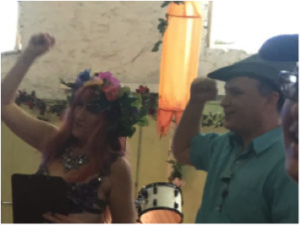 Gershwin!
Gershwin!
I belt out, “You’re wonderful!”
The crowd roars and the organizer says, “Yes! Like that! Tell her more!” So, I sing,
“You’re marvelous!”
Of the things I never expected to do as Author of the year, crooning old standards was probably high on the list, but as with all writing… you go where the story takes you and do what the story demands!
Thank you to the organizers of the Baltimore Faerie Faire! I had such a great time. I am both humbled and honored that you embraced my work. I will remember this weekend for a long time.
Oh… and for the record, I did eat faerie fare at the faire. Surprisingly, it tasted like chicken, Masala chicken to be specific.
 Author Bio:
Author Bio:
Andrew Hiller is the author of A Halo of Mushrooms, A Climbing Stock and the editor of Thursday Stories. Follow him on Twitter as @AndrewHiller.
If you’re an author or other fantasy and science fiction creative, and want to do a guest blog post, please check out the guest blog post guidelines





